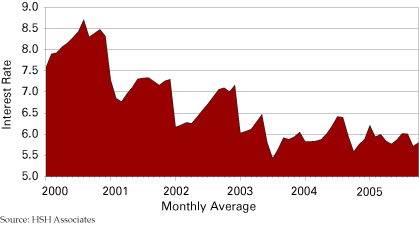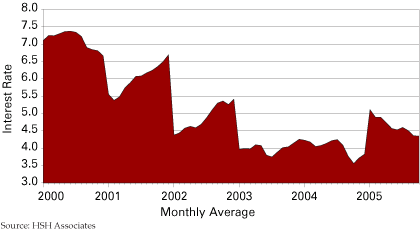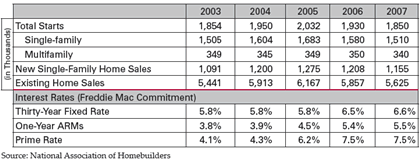Housing
Kelley School of Business, Indiana University, Bloomington
The national housing sector has benefited significantly from low long-term interest rates in recent years. The Fed’s hikes in short-term rates after mid-2004 did little to dampen housing demand. There has been talk of a housing bubble in many areas of the country as home prices have risen considerably compared to historical levels. Prices have also risen much faster than rental rates, analogous to having a high price-earnings ratio for houses. Average national home prices have not dropped since the Great Depression but the recent frenzy in the real estate market has investors wondering if the market can maintain this pace. Housing prices have risen and popped in past years. Texas collapsed in 1986, Southern California in 1989, and Massachusetts and Connecticut in 1991. But the debate continues over whether a nationwide bubble has materialized.
Some compare today’s coastal housing market, where prices increased the most, to the investment craze that led to the technology stock crash a few years ago. Home prices in some regions have more than doubled in the past five years, leading to concerns that the speculative bubble might burst. There have also been record levels of conversion of apartments into condominiums in many areas of the country as demand for homeownership has also led to increased demand for condominiums. Investors can earn a greater profit by selling apartments as condos rather than renting apartments. In markets like Miami, where the condo market has been particularly hot, some units have even changed hands the same day as speculators have been buying many of the condos.
The bad news for homeowners in Indiana is that they have not seen their home values rise like many other areas of the country. The Indianapolis area’s home prices grew at nearly the slowest pace of the top fifty markets, or 19 percent during the past five years. Homeowners in the Boston and San Diego areas saw their homes appreciate more than 75 percent during the same period.
The good news is what has not gone up will probably not go down. That is, home prices in Indiana are not likely to fall with a possible drop in prices in those areas of the country that may be experiencing a bubble. So there is less risk associated with purchasing a home in Indiana compared to many other areas of the country. This also makes homes in Indiana relatively affordable compared to many other areas.
Of course, it can be painful for someone who plans to sell a home in the Midwest where the median home price is $174,100 and move to another area like the Northeast where the median is $252,900 or the West where the median is $327,300. Whether such an extreme difference in median home prices is sustainable is questionable.
A countrywide meltdown in housing prices could have a profound effect on the economy, as more Americans are invested in real estate than in stocks. A decline in housing prices would have a very serious effect on the economy because housing has been supporting the economy ever since the recession. Roughly 5 percent of the gross domestic product is associated with homebuilding and construction. Furthermore, there has been a consumption boom based on people taking out second mortgages and refinancing their homes.
However, most economists do not expect a national decrease in home prices. Housing is very dependent on the local economy and the markets that have experienced the rapid increase in prices have also had rising household income.
Sales of existing homes held at the second highest pace on record in September 2005, with sales surging in some areas following Hurricane Katrina. Rebuilding in Louisiana and Mississippi will likely keep the housing market strong through 2006, as long as mortgage interest rates do not rise too much. The recent trends in fixed and adjustable interest rates are shown in Figures 1 and 2.
Figure 1
Thirty-Year Fixed Rate Mortgates

Figure 2
One-Year Adjustable Rate Mortgages

Mortgage rates could increase from their current level if the Fed continues to increase interest rates. The National Association of Homebuilders projects rates for fixed rate mortgages to rise from their current levels of less than 6 percent to about 6.5 percent in 2006, whereas the Indiana University econometric model forecasts a slightly higher 7 percent rate. In either case, these rates are still at historically low levels and are not likely to have much of an adverse effect on housing demand. Housing starts could drop slightly during 2006, although as mentioned above, rebuilding due to Katrina will add to the demand.
Table 1 shows the recent historical levels and forecast for housing and interest rates from the National Association of Home Builders (www.NAHB.org). Housing starts and new home sales are forecast to drop slightly in 2006 and 2007 as mortgage interest rates rise. The underlying fundamentals remain relatively strong and the decline is mainly due to a drop off from the boom we have been experiencing.
Table 1
Indiana’s Housing and Interest Rate Forecast
Also in this Issue…




